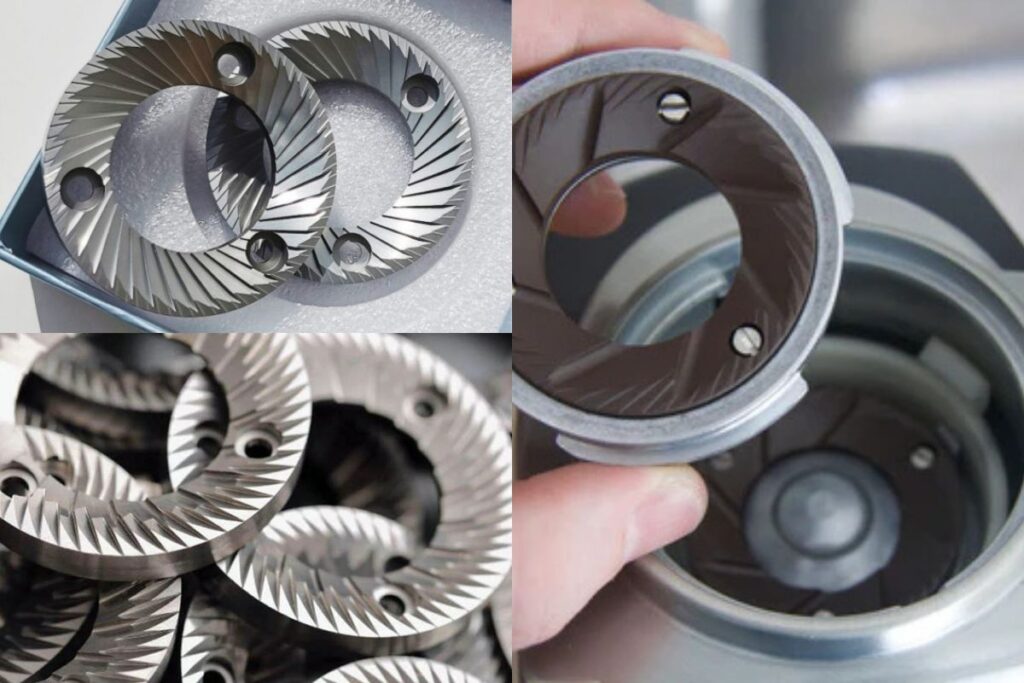When it comes to making a great cup of coffee, the type of grinder you use can have a significant impact on the flavor. One popular option among coffee enthusiasts is the flat burr grinder. If you’re unfamiliar with what a flat burr coffee grinder is, or you’re considering upgrading your grinder, this post will help you understand its features, benefits, and why it’s a preferred choice for many coffee lovers.
What is a Flat Burr Coffee Grinder?
A flat burr grinder is a type of coffee grinder that uses two flat, ring-shaped burrs to grind coffee beans into uniform particles. These burrs sit parallel to each other, and the coffee beans are ground between them as they pass through the narrow gap. The size of this gap can be adjusted to produce finer or coarser grounds, depending on the brewing method you prefer.
Unlike blade grinders, which chop the beans into irregularly sized pieces, burr grinders—especially flat burr grinders—produce consistent and even grounds, which is key for brewing balanced, flavorful coffee.
How Does a Flat Burr Coffee Grinder Work?
The design of a flat burr grinder is relatively simple but effective. The two flat burrs face each other horizontally, with one typically stationary and the other rotating. Coffee beans are fed through the middle of the burrs and get crushed between the two discs. By adjusting the distance between the burrs, you control the grind size, allowing for greater precision.
The grinding process begins when the beans are fed through a hopper, and as they move through the burrs, they’re ground to a specific size before falling into the collection chamber. The uniformity of the grounds is what makes flat burr grinders a favorite among baristas and home coffee enthusiasts.
Why Choose a Flat Burr Grinder Over a Blade Grinder?
One of the main reasons people choose flat burr grinders over blade grinders is consistency. Blade grinders work by chopping beans with rotating blades, much like a blender. This method can produce uneven grounds, leading to inconsistent extraction during brewing. Uneven grounds can result in some coffee being over-extracted, making it taste bitter, while other grounds are under-extracted, leading to sour notes.
In contrast, flat burr grinders produce a much more uniform grind. When your coffee grounds are consistent in size, your brew will be more balanced, and the flavors will shine through without unwanted bitterness or sourness.

Flat Burr vs. Conical Burr Grinders
While flat burr grinders are highly praised for their precision, you may have heard of another type of grinder: the conical burr grinder. Conical burr grinders feature two cone-shaped burrs, and they work similarly to flat burr grinders by crushing the coffee beans between them.
The primary difference between flat and conical burrs is their shape. Flat burrs are known for producing more uniform particle sizes, while conical burrs produce a bimodal distribution of coffee grounds, meaning some particles will be slightly larger or smaller than others. This can affect extraction, but not always in a negative way.
Choosing between a flat burr and conical burr grinder depends on your personal preferences and brewing style. Flat burr grinders are often preferred for espresso due to their consistency, while conical burrs are commonly used for a variety of brewing methods, including pour-over and drip coffee.
Benefits of a Flat Burr Coffee Grinder
1. Grind Consistency
The most significant advantage of using a flat burr grinder is its ability to produce consistently sized coffee grounds. This consistency is crucial for achieving an even extraction, which in turn enhances the flavor of your coffee. Whether you’re brewing espresso or using a French press, flat burr grinders ensure your coffee is ground to the optimal size for your chosen method.
2. Precision Control
Flat burr grinders offer excellent control over the grind size. Most flat burr grinders allow you to make micro-adjustments to the burrs, giving you the flexibility to grind coffee for a wide range of brewing methods. From ultra-fine espresso grinds to coarser settings for French press, the ability to precisely control your grind is a game-changer for coffee aficionados.
3. Durability
Flat burr grinders are known for their durability. The burrs themselves are typically made from high-quality materials like stainless steel or ceramic, which ensures they can handle regular use without wearing out quickly. Flat burr grinders are built to last, making them a good investment for serious coffee drinkers.
4. Suitable for Espresso
For espresso lovers, flat burr grinders are often considered the best choice. The fine grind required for espresso demands precision, and the consistent grind size that flat burrs provide is ideal for pulling a rich, balanced shot. In fact, many commercial espresso machines are paired with flat burr grinders because of their accuracy and reliability.
5. Less Heat Transfer
Heat is the enemy of fresh coffee, as it can cause the beans to lose their aroma and flavor. Flat burr grinders are designed to minimize heat buildup during grinding. Because the beans are crushed slowly between the burrs rather than rapidly chopped, there’s less friction, which helps preserve the beans’ natural flavors.
Are There Any Downsides?
While flat burr grinders offer many advantages, they aren’t without their drawbacks. One common concern is that they can be noisier than other grinders, especially compared to conical burr grinders. The flat burrs tend to operate at a higher RPM (revolutions per minute), which can generate more noise during the grinding process.
Another potential downside is that flat burr grinders can retain more grounds between the burrs and the grinding chamber. This “retention” means that you might need to clean your grinder more frequently to ensure that stale grounds don’t mix with freshly ground coffee.
Additionally, flat burr grinders are generally more expensive than blade grinders and even some conical burr grinders. However, the investment is often worth it for those who are serious about their coffee and want the best possible results.
How to Choose the Right Flat Burr Grinder
If you’re considering a flat burr grinder, there are a few factors to keep in mind:
1. Grind Settings
Look for a grinder that offers a wide range of grind settings. This flexibility will allow you to grind for different brewing methods, from espresso to pour-over. Some high-end models offer stepless adjustments, which means you can fine-tune the grind size to your exact preference.
2. Material and Build Quality
Pay attention to the materials used in the grinder. Burrs made from stainless steel or ceramic are durable and can withstand regular use. The overall build quality of the grinder should also be sturdy, especially if you plan to use it frequently.
3. Motor Power
A powerful motor is essential for grinding coffee beans efficiently without generating excessive heat. Look for grinders with motors that operate at lower speeds, as these are less likely to overheat your beans during grinding.
4. Hopper Capacity
Consider how much coffee you plan to grind at once. If you only make a cup or two each day, a smaller hopper might suffice. However, if you brew larger quantities or frequently entertain guests, a grinder with a larger hopper capacity might be more convenient.
5. Ease of Cleaning
Since flat burr grinders can retain grounds, choose a model that’s easy to disassemble and clean. Regular maintenance will ensure that your grinder performs well and doesn’t affect the flavor of your coffee over time.
Related Post: Types of Coffee Grinders
Conclusion
A flat burr coffee grinder is an excellent investment for anyone serious about coffee. Its ability to produce consistent, uniform grounds ensures that your coffee will taste balanced and flavorful, regardless of your brewing method. While it may require a bit of an upfront investment, the benefits in terms of precision, durability, and grind control make flat burr grinders a top choice for both home baristas and professionals.
Frequently Asked Questions about Flat Burr Coffee Grinders
What is a flat burr coffee grinder?
A flat burr coffee grinder uses two parallel burrs to crush coffee beans into uniform particles for consistent and precise grinding.
How does a flat burr grinder differ from a blade grinder?
Flat burr grinders provide uniform grounds by crushing beans, while blade grinders chop them unevenly, leading to inconsistent extraction.
Is a flat burr grinder better for espresso?
Yes, flat burr grinders are often preferred for espresso because they produce precise and consistent fine grounds, essential for balanced shots.
What is the difference between flat burr and conical burr grinders?
Flat burr grinders produce more uniform grounds, while conical burr grinders create a mix of particle sizes, which can affect extraction in different ways.
Why are flat burr grinders more expensive?
Flat burr grinders are more expensive due to their precise design, durable materials, and superior grind consistency, making them a worthwhile investment.
Do flat burr grinders heat the beans more than conical burr grinders?
Flat burr grinders can generate slightly more heat due to higher RPM, but quality models are designed to minimize heat transfer during grinding.
Are flat burr grinders noisy?
Flat burr grinders tend to be noisier than other types, as they operate at higher speeds, but this varies by model.
How often should I clean a flat burr grinder?
It’s recommended to clean your flat burr grinder every 1-2 weeks, depending on usage, to prevent old grounds from affecting the flavor of fresh coffee.
Can I grind for all brew methods with a flat burr grinder?
Yes, flat burr grinders offer a wide range of grind settings, allowing you to grind for various methods such as espresso, pour-over, and French press.
What are flat burrs made of?
Flat burrs are typically made from stainless steel or ceramic, materials known for their durability and resistance to wear.






